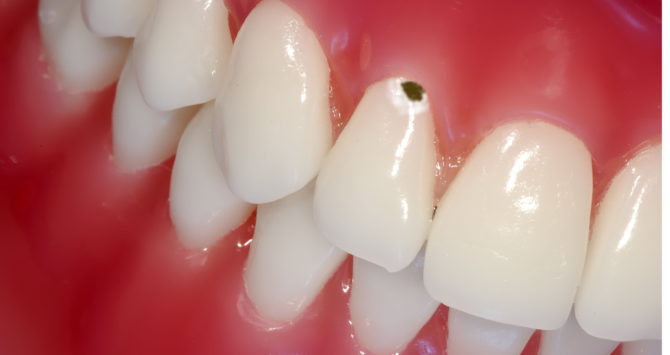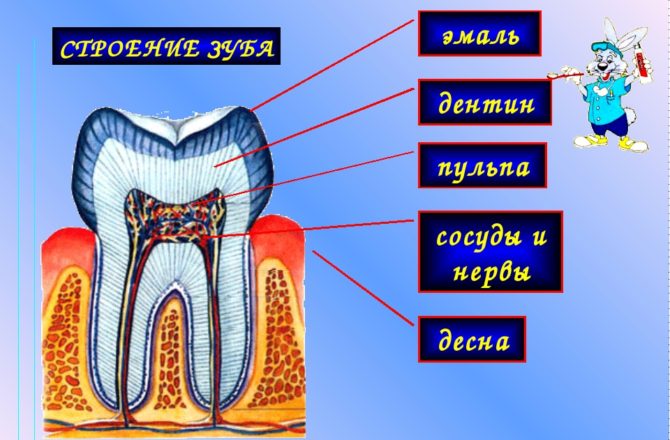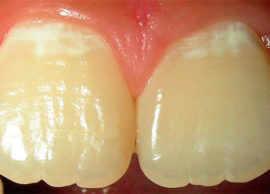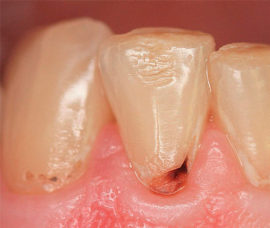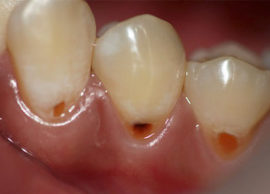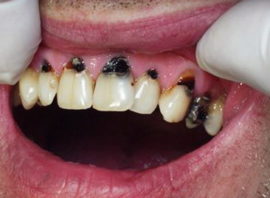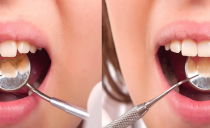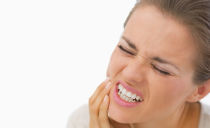Cervical caries at the base of the tooth: causes, treatment, prevention
Caries, no matter where it strikes, is dangerous to humans. Its danger is not limited to the risk of tooth loss, with the active reproduction of microbes the carious cavity becomes the focus of the spread of infection that can affect any internal organ.
If the disease begins at the base of the crown, in the neck, the number of risks increases due to the anatomical features of this site. Therefore, it is desirable to know everyone about cervical or cervical caries, the causes of its occurrence and treatment.
Content
Development mechanism
The tooth receives nutrients and is innervated through the pulp - a soft inner tissue with nerves and tiny vessels. The pulp chamber is surrounded on all sides by dentin. There is an enamel layer above the dentin in the area of the crown and neck, and cement in the area of the root, which is in contact with the ligaments that ensure the fixation of the tooth in the jaw alveoli. The layer of enamel and cement should be quite thick to reliably protect soft tissue from irritants, injuries and provide chewing function of the dentition.
Carious tooth decay in the cervical region is called cervical caries. Often, patients use synonyms for the diagnosis of gum or basal caries. This disease occurs when the enamel layer is damaged, over time, a depression appears at the site of damage, then a cavity that descends to the pulp. Dentists distinguish such stages of the development of pathology:
- A whitish speck on tooth enamel.
- Slight damage to the enamel with the appearance of hyperesthesia (increased sensitivity to temperature and chemical irritants).
- Damage to dentin with exacerbation of sensitivity. The patient feels pain, but it quickly passes.
- The expansion and approximation of the black carious cavity to the pulp, the pain from hyperesthesia becomes unbearable.
If the lesion affects the lateral area of the tooth above its connection with the gum, caries is called gingival. Destruction of the tooth shell below this line is called subgingival caries.
Causes of cervical caries
Caries at the base of the tooth develops for the same reasons as in any other part of the crown:
- The leading cause of frequency of occurrence is non-compliance with hygiene or a rare and improper brushing of teeth, in which plaque is not removed from the crown or neck.
- The inherited vulnerability of the enamel layer - in some people it is thinner than in others.
- Deficiency of the structural elements that form dental tissues due to irrational and malnutrition or metabolic failures.
- Destruction of tissue due to hormonal imbalance.
- Deficiency of the protective function of saliva: sometimes it is produced too little, and a lack of bactericidal substances provokes the active reproduction of pathogens in the oral cavity.
- Taking certain drugs that destroy the enamel layer.
- Drinking low-quality drinking water.
- Destruction of enamel by nicotine and alcohol.
- At an accelerated pace, tooth damage occurs during pregnancy, since hormonal changes often occur during this period, and nutrients massively go to the fetus.
- In children, the teeth are destroyed if they often fall asleep during feeding, and food stays in their mouth for a long time.
Another factor provoking the development of cervical caries on the teeth is a thinner enamel layer in the neck. Such a defect is fraught with more deplorable consequences, since with its presence, the probability of a fracture of the tooth increases. Such a pathological process often leads to the loss of a crown in people of middle and old age.
Diagnosis of basal caries
To detect cervical caries, it is enough to carefully examine the tooth. It is faster and easier to identify lesions of the front teeth, as a person more often sees them in the mirror. The development of the disease is indicated by spots, fossae or deep dark cavities on the gingival surface of the teeth, as well as an increase in their sensitivity.
If root caries is detected, you do not need to do anything at home, it is better to immediately contact a dentist and begin competent and more effective treatment. This diagnosis can be confused with a wedge-shaped defect that appears on some front teeth, especially on fangs and chewing premolars. With such a disease, the enamel remains dense, and the symptoms develop for a long time, and a carious lesion leads to loosening of the enamel and develops much faster - but it is still better to entrust the diagnosis and determination of the treatment regimen to the doctor.
You can see how the teeth look before and after cervical caries treatment in the photo:
In dentistry, cervical caries is determined during an examination, but for a more accurate diagnosis, a method can be used that involves applying a special solution to the teeth that stains only the destroyed enamel. Thanks to him, damaged areas differ from healthy ones in color.
In order to identify the cause of the origin of radical caries, it is necessary to conduct additional examinations:
- X-ray.
- Electrodontometry.
- Transillumination.
- Radiovisiography.
How to treat radical caries
Teeth affected by cervical caries are treated differently - the treatment regimen depends on the stage of development of the disease. But regardless of the degree of neglect of the disease, anesthesia is always used during treatment, since the area near the neck of the tooth is extremely sensitive, and its irritation during medical manipulations causes severe pain.
| Stage of the disease | Healing procedures |
|---|---|
|
Enamel stain stage |
Cleansing the affected area from plaque, and when it hardens - from tartar. Drawing on a carious spot of remineralizing fluorinated varnishes. |
|
The second stage with damage to the surface layers of enamel |
Elimination of plaque and destroyed enamel layer. Remineralizing therapy to restore damaged tooth shell. |
|
Stage Three - Dentin Damage |
Cleaning the surface from plaque and removing tissue residues from the cavity. Antiseptic treatment. Filling. Correction of the filling, taking into account the characteristics of the bite. |
|
Stage of deep caries |
Cleaning the tooth from surface contamination. Depulpation - removal of living soft pulp tissue along with the nerve. Root canal cleaning. Filling canals with filling material and layer-by-layer filling. Correction of the seal. |
With the spread of caries in the pulp and subgingival space, complications develop in the form of pulpitis, periodontitis, inflammation of the gums near the tooth - all of them require a longer and more complicated treatment.
The nuances of professional treatment of cervical caries
It is more difficult for dentists to restore a tooth affected by this form of the disease, since cervical caries develops on the neck of the tooth - a site difficult to access for tools. The risk of injury by an instrument also increases, since the enamel in this area is thin, and the gum is in close proximity to the site of the manipulation.
It is very important to determine why this defect developed, because in many patients, the causes of tooth decay lie in internal diseasesto be diagnosed and treated. If chronic diseases (hormonal, metabolic disorders) are not completely cured or periodically treated, dental procedures will be ineffective, and the dentition will still be destroyed. Therefore, if there are several diseased teeth, the dentist may recommend contacting a therapist or endocrinologist and do all the necessary tests.
Cervical caries treatment at home
After professional medical procedures, it is recommended to continue treatment at home, using fluoride, calcium and toothpastes prescribed by the dentist to combat cervical and other forms of caries. Recommended Pastes:
 Splat Liquid Gel.
Splat Liquid Gel.- Splash Biocalcium.
- President Classic.
- Lacalut Aktiv.
- Elmeks "Protection against caries."
- O.C.S. "Caribbean Summer."
But the treatment of cervical caries at home is not so effective as to cancel the trip to the doctor - a visit to the dentist is necessary even in the initial stages of the lesion. Only a doctor will be able to determine the degree of destruction of enamel and apply optimal treatment methods. Patients who try to be treated at home using folk remedies lose valuable time and the opportunity to save a bad tooth. And with the spread of pathology, there is a risk of destroying the enamel of several more teeth located nearby.
Folk remedies can be used either to prevent caries, or as a complement to traditional treatment. The use of fresh fibrous vegetables and fruits helps to reduce the accumulation of plaque around the teeth. To eliminate food residues after eating, you can rinse with sage, chamomile broth, calamus tincture. The elimination of deposits around the teeth helps chewing calamus roots.
Cervical caries prophylaxis
Prevention of cervical caries is to comply with all those rules that relate to maintaining healthy oral cavity. This means that you can not forget about two-time brushing and rinsing the gums after eating with pharmacy or homemade herbal rinses. You need to eat right, in the presence of diseases - to monitor the state of metabolism and hormonal levels. A special recommendation to prevent the gingival form of the disease is a more thorough cleaning of the tooth neck: you need to very well clean the gaps between the teeth and between the crown and gum.
If the initial stages of development of cervical or other caries are noticed, you should immediately go to the dentist to prevent the negative consequences in the form of a crown fracture or complete tooth loss. The earlier a defect is noticed, the less time it will take to fix it., less discomfort will have to be transferred during dental procedures.
To prevent the occurrence of any dental disease, it is advisable to go to the dentist a couple of times a year, so that he examines the dentition and conduct professional cleaning. At home, using only a brush and regular toothpaste, thorough toothbrushing is impossible, especially from the side, in the interdental spaces and near the neck. In modern clinics, this procedure is performed using special devices.
If unusual spots appear in the gingival region of the dentition, this defect cannot be ignored. This is a sign of a dental problem that needs to be addressed as soon as possible. If the patient is afraid to go to the dentist and delays the moment of visiting the clinic, he dooms himself to even more unpleasant sensations during the treatment, since during this time caries manages to destroy a significant part of the neck and crown.

